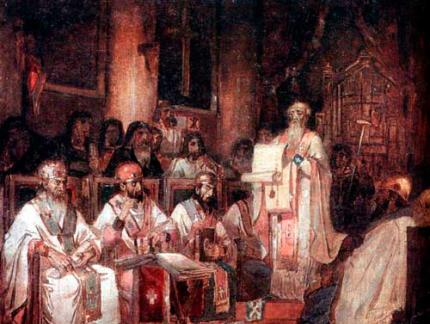Write-off of products on 43 accounts using an example. Excluding deviations from the planned cost
Manufacturing enterprises that have chosen directly to manufacture finished products or semi-finished products for their core business are faced with the task of reflecting and registering such business processes in regulated accounting. In this article, we offer step-by-step instructions for accounting for the production and release of finished products 1C 8.3 using the configuration "1C: Enterprise Accounting, revision 3.0".
Step 1: checking production functionality
To get started, make sure that our configuration allows you to keep track of finished products in 1C 8.3.
In the "Administration" in the settings, click on the link "Functionality".
We are interested in the functionality of the production accounting system, which can be found on the corresponding tab.

We see that in this part of the function are used and cannot be turned off. On this, the first step is considered complete.
Step 2: set up accounting policies
The setting is also implemented in the main menu of the system from the “Main” section, the “Settings” subsection, the “Accounting Policy” hyperlink.

The accounting policy is configured for a specific organization, then we pay attention to the types of activities for account 20 and set the flag for accounting for the release of goods.

Note! At the bottom of the figure, there are three additional options that also affect our accounting method:
- Accounting for deviations - the inclusion of this flag means the use of account 40 "Output of products (works, services)";
- In terms of semi-finished products - the inclusion of this flag means taking into account multi-production and requires the establishment of a sequence of redistribution;
- Services to own divisions - the inclusion of this flag means accounting for the counter-issue, and requires setting the counter-counter register in order to prevent the calculation of the cost of goods from cycling.
We are considering the option without the use of account 40, counter issues and semi-finished products.
This step is completed, we have completed the necessary policy settings.
Step 3: register issues at planned cost
In the main menu of the system, the “Production” section is responsible for accounting for production processes, and a separate subsection is devoted to the issue itself.

- Requirement-invoice - allows you to register the transfer of materials to production or any other write-off of them to costs. An issue can be registered without it, but it depends on the setting of the production business process;
- Production report per shift - registers the output for the planned s / s and at the same time write off the materials for production.
Let us analyze in detail the work with the production report for a shift.
We will create a new document and fill it out taking into account the release of one type of goods according to a simple production specification.

In addition to the name of the company and the warehouse, from where the material is taken and where the released goods are placed, in the header you will need to indicate the cost account and the production unit of the costs.
To fill out the tabular part, indicators should be entered into the system in the nomenclature directory, which will contain information about the varieties of manufactured goods.

The item card must be in the form of “Products”. For separate accounting in the account of the costs of the main production, it is necessary to fill out an inventory group. To write off materials for products released automatically requires filling out a specification that can be created directly from this card.

Put our next action on the “Products” plate, the quantity of release, put down the planned price, specification. The lines “Account of account” and “Nomenclature group” will be filled in automatically according to the data of the nomenclature card.
To write off materials and make them part of the s / s, the Materials tab is filled out. If there is a specification, filling will happen automatically by clicking the "Fill" button.

To complete this step of accounting follows the conduct of the created form. Formed postings reflect the accounting of production and finished goods in 1C 8.3.

Analyzing the postings, we see that the credit of the account 20 reflects the planned cost, and the debit 20 of the account contains the actual costs. For the correct calculation, you need to understand the actual cost of finished goods.
Step 4: calculate the actual cost of production
Before calculating the actual s / s, the system should reflect all the necessary costs in the main production account. In addition to raw materials, this may be the salary of workers, depreciation of equipment, other expenses. This calculation is started through the "Closing of the month."

Calculation of the current is possible with the calculations of previous periods.

If the period is closed without errors, then all operations are displayed in green. To check the calculation of cost, let's see what postings were formed on closing cost accounts. To do this, select the appropriate operation "Show transactions".


Calculation made adjustment of the issue, this is reflected in the first posting. The posting forms a reversal record because the planned cost was greater than the actual costs.
Step 5: analyze reports on the actual cost of goods
In conclusion, it remains for us to do accounting reports on cost accounts and finished goods. Earlier, in our example, we did not reflect work in progress, assuming that all products were put into storage and there were no processed raw materials left in the shops of the enterprise. This means that the balance of the main production account must be zero, and the actual cost of production was formed on the finished goods account.

We see that account 20 is closed.

The calculation is correct. The next step will be the accounting for the sale of finished products in 1C 8.3.
Account 43 "Finished products" is intended to summarize information on the availability and movement of finished products. This account is used by organizations engaged in industrial, agricultural and other production activities.
In accordance with the current provisions, finished products are considered part of the inventories intended for sale (the final result of the production cycle, assets completed by processing (packaging), the technical and quality characteristics of which comply with the terms of the contract or the requirements of other documents, in cases established by law). The delivery of finished products to a warehouse or customer, when the finished product is delivered on the spot, must be documented by established delivery documents. Products that do not meet these conditions are considered work in progress.
Finished products purchased for picking (the value of which is not included in the cost of production) or as goods for sale are recorded on account 41 “Goods”. The cost of work performed and services rendered on account 43 “Finished products” is not reflected, and the actual costs are deducted from the accounts of production costs or accounts 40 “Production (work, services)” to account 90 “Sales” as they are sold, subaccount 02 "Cost".
Finished products, subject to delivery to customers on site and not executed by an acceptance certificate, remain part of the work in progress; in the composition of products taken into account on account 43 "Finished products", such products are not included.
Subaccounts may be opened to account 43 "Finished goods":
43-01 "Planned cost of production"; 43-
02 "Deviations from the planned cost"; 43-
03 "Actual production cost."
Depending on the method of accounting for finished products chosen in the accounting policy, the organization uses sub-accounts: -
when using account 40 “Output of products (work, services)” to account for manufactured products, the organization uses subaccount 43-01 “Planned cost”; -
when choosing a method of accounting for finished products at actual cost, the organization can use subaccount 43-03 "Actual production cost"; -
if, when accounting for finished products at actual production costs, the organization in the analytical accounting reflects the movement of individual items at discount prices with deviations, then it uses sub-accounts 43-01 “Planned cost” and 43-02 “Deviations from planned cost”.
Posting of finished products manufactured for sale, including products partially intended for own needs, is reflected in the debit of account 43 "Finished products". If the finished product is completely sent for use at the enterprise itself, then it may not be on account 43 “Finished products”, but it is recorded on account 10 “Materials” and other similar accounts, depending on the purpose of this product.
When using account 40 “Output of products (works, services)” for accounting for manufactured products, finished products are reflected in account 43 “Ready products” at the planned cost price. At the same time, account 43 “Finished products” (subaccount 01 “Planned cost”) is debited in correspondence with account 40 “Production output (works, services)” (subaccount 01 “Normative (planned) cost”). The difference between the actual and planned cost is determined on account 40 "Production (work, services)".
When accounting for finished products at actual cost in subaccount 43-03 "Actual production cost", its capitalization is recorded at the debit of this subaccount in correspondence with credit of accounts: 20 "Main production", 23 "Auxiliary production", 29 "Serving production and enterprises".
If the finished product is accounted for on account 43 "Finished products" at the actual cost with the allocation of accounting prices and deviations, then the posting of finished products to the warehouse is reflected in the entries:
The debit of subaccount 43-01 "planned cost"
Credit of accounts 20 "Main production", 23 "Auxiliary production", 29 "Serving production and economy" -
accounting price of finished products (planned cost, selling prices, etc.);
The debit of subaccount 43-02 "Deviations from the planned cost"
W.W.W ... I.n.e.t.L.i.b: Ru.
Credit of the same accounts -
deviations of the actual cost of finished products from the planned.
In the case of choosing this method of accounting in the accounting policy when writing off finished products, the amount of deviations related to these products is determined by the percentage calculated based on the ratio of deviations to the balance of finished products at the beginning of the reporting period and deviations for products received at the warehouse during the reporting month, to the cost of this product at discount prices.
Finished products shipped or delivered on the spot to buyers (customers) are debited from account 43 "Finished products" in correspondence with account 90 "Sales", subaccount 02 "Cost".
If the supply contract determines the moments of transfer of ownership, use and disposal of the shipped products and the risk of their accidental damage from the enterprise to the buyer (customer), other than the time of shipment (for example, when exporting products), then up to that point these products are recorded on account 45 " Goods shipped ", subaccount 01" Goods and products shipped ".
Finished products transferred to other enterprises for sale on a commission and other similar basis are also debited from account 43 “Finished products” to the debit of account 45 “Goods shipped”, subaccount 05 “Goods for sale on a commission basis”.
Amounts recorded on account 45 "Goods shipped" are debited to account 90 "Sales" (subaccount 02 "Cost") at the time of recognition of the proceeds from the sale of products or upon receipt of a notice from the commission agent about the sale of products transferred to him.
When transferring finished products for use in the organization itself, its value is reflected in the credit of account 43 “Finished products” and the debit of account 08 “Investments in non-current assets” or 10 “Materials” (depending on the service life).
The cost of the gratuitously transferred products is recognized by other non-operating expenses and debited from account 43 “Finished products” to the debit of subaccount 91-02 “Other expenses”.
Identified during the inventory surplus of finished goods accounted for in the warehouse on the debit of account 43 "Finished goods" and are included in the financial results of the organization. If shortages of finished products and losses from its damage are detected, account 43 “Finished products” is credited in correspondence with account 94 “Shortages and losses from damage to values”.
Analytical accounting of the account 43 "Finished products" is carried out at the places of storage of finished products and certain types of finished products.
Table 4.4.
Account 43 "Finished goods" corresponds with the accounts For debit On credit 20 "Main production" 10 "Materials" 23 "Auxiliary production" 20 "Main production" 29 "Service industries and farms" 23 "Auxiliary production" 40 "Production output (works , services) "25" General production expenses "7 9" Internal business settlements "2 6" General economic expenses "8 0" Share capital "28" Marriage in production "91" Other income and expenses "4 4" Costs to sell "4 5" Goods shipped "7 6" Settlements with different debtors and creditors "7 9" B “8 0” business calculations; Share capital “90”; Sales; 94; -
Finished products - this is the end result of the production cycle, which is intended for sale inventories that are finished by processing (packaging), technical and quality characteristics of which correspond to the terms of the contract or the requirements of other documents (paragraph 199 of the Order of the Ministry of Finance dated 28.12.2001 No. 119н ) And how is the synthetic and analytical accounting of finished products organized?
Account 43 “Finished goods”
For conducting synthetic accounting of finished products, the Chart of Accounts and the Instructions for its Application use account 43 “Finished Products” (Order of the Ministry of Finance of October 31, 2000 No. 94n). This account summarizes information on the availability and movement of finished products by organizations that conduct industrial, agricultural and other industrial activities.
How finished products account for account 43, i.e., issues of finished goods production, we considered separately.
Recall that to account for the cost of work performed and services rendered, account 43 is not used. Actual costs on them at the time of sale are debited from the credit of the accounts of the account in the debit of account 90 "Sales".
In the case when the manufactured products are used in the organization itself, it may not be necessary at the time of its release to account 43, but may be reflected, for example, as part of the materials on account 10 “Materials”.
How sales of finished products are taken into account, we told in this
", November 2017
Both beginners and experienced users have questions about closing 20, 23.25.25 accounts. On the example of the program "1C: Accounting 8", ed. 3.0, consider what settings need to be made so that costly accounts are closed monthly correctly.
Account policy setting
The accounting policy of the organization is created in the program annually, along with it the directories are filled out: methods for determining indirect costs and a list of direct costs.
The screenshot shows that it is possible to set two checkmarks:
« Output" - should stand with those organizations that are engaged in production.
« Performance of work, provision of services to customers"- must stand with organizations that specialize in the provision of production services.
If none of these settings is selected, it is understood that the program is focused on trade-oriented organizations - “bought-sold” - nothing will be produced and no services will be provided, therefore, an account in the activities of such an organization will not be used at all.
Recommendations for fixing errors that occur when closing a month
Such a situation is very common that the closing of the month was successful, the program did not produce any errors, but when creating the balance-sheet, the user notices that on 20.01 the account was closed on the account on 90.08 or did not close at all. You must do the following:
look at the postings in the regulatory operation “Closing accounts: 20, 23, 25, 26” to which account the account was closed. If it closed on 90.08, then you need to check the list of direct costs, maybe there are not enough entries;
according to the report “Analysis of subconto: nomenclature group to analyze for which nomenclature group and cost item there was no full / partial closure of the account / to the account 90.02. If the direct expense accounts did not close at the cost of production, this may mean that the program has work in progress, does not reach the entries in the list of direct costs, or there is no revenue for this item group.
After checking the documents and making changes to them, you must re-close the month.
It also happens that a program throws errors indicating where the problem is and what needs to be done to correct these errors. Everything is simple here, you should read all the information that the program issued, and correct the errors, following the recommendations, and close the month again.
In conclusion, let us once again draw attention to the fact that the accounting policy of the organization is created annually, and with it the methods of distribution of indirect costs and a list of direct costs are created. The list of direct costs is the key, precisely due to the presence of entries in it, the program "1C: Accounting 8", ed. 3.0, determines what, when closing the month, write off to indirect costs, and what to direct.
Finished products - the main result of the production process of the enterprise. It appears in the form of products and items, the processing of which in this organization is fully completed, in accordance with the standards and technical specifications adopted by the Quality Department and transferred to the finished goods warehouse. Consider the typical postings for the issue and accounting and account.
Tasks of accounting for finished products in accounting:
- constant monitoring of the volume of finished products and their quality, safety of stocks and their size;
- timely and competent documentation of products shipped to customers;
- clear control over the supply of finished products and their compliance with the concluded agreements on the quantity, nomenclature and assortment;
- accurate and timely calculation of the amount of revenue from sales, actual cost and profit.
Production and output of finished products in postings on 43 and 40 accounts
The output of finished products is accounted for at the planned or actual cost. In the first case, it is used, from which the actual cost is then written off to, and the difference between the actual cost and the planned cost in correspondence with the account .02 is adjusted by a separate posting.
Postings:
| Account Dt | Score CT | Wiring description | Post Amount | A document base |
| () | ( , ) | Finished products are discontinued from production and put into storage at their actual cost | 5000 | Reference calculation, costing |
| The finished finished products are taken into account at their planned cost | 5100 | Reference calculation, the act of finished goods | ||
| .02 | Adjusted the difference in the cost of finished products (saving) | 100 | Reference calculation (closing of the month) |
How to reflect product sales in transactions
The sales volume includes all finished products shipped to customers, regardless of whether they are paid or not. Sales of products can occur both with their subsequent payment after shipment, and in advance.
Postings:
| Account Dt | Score CT | Wiring description | Post Amount | A document base |
| 1. The sale of finished products to its payment by the buyer | ||||
| 90.02 | Sent finished products for sale at its actual cost | 5000 | Consignment note (TORG-12) | |
| 90.01 | Reflected revenue for products sold with VAT | 7080 | Consignment note (TORG-12) and invoice | |
| Reflected VAT on products sold | 1080 | |||
| Supplier debt for goods shipped | 7080 | |||
| 2. Selling finished goods on an advance payment | ||||
| Prepayment received from buyer | 7080 | Payment order, bank statement | ||
| 76 | Accrued VAT on prepayment | 1080 | Sales book, | |
| 90.02 | 5000 | Consignment note (TORG-12), invoice | ||
| 90.01 | Sales revenue included | 7080 | Consignment note (TORG-12), invoice | |
| The advance payment received earlier is calculated as repayment of debt to the buyer | 7080 | Help calculation | ||
| 76 | Read VAT on prepayment repayment | 1080 | Invoice | |






